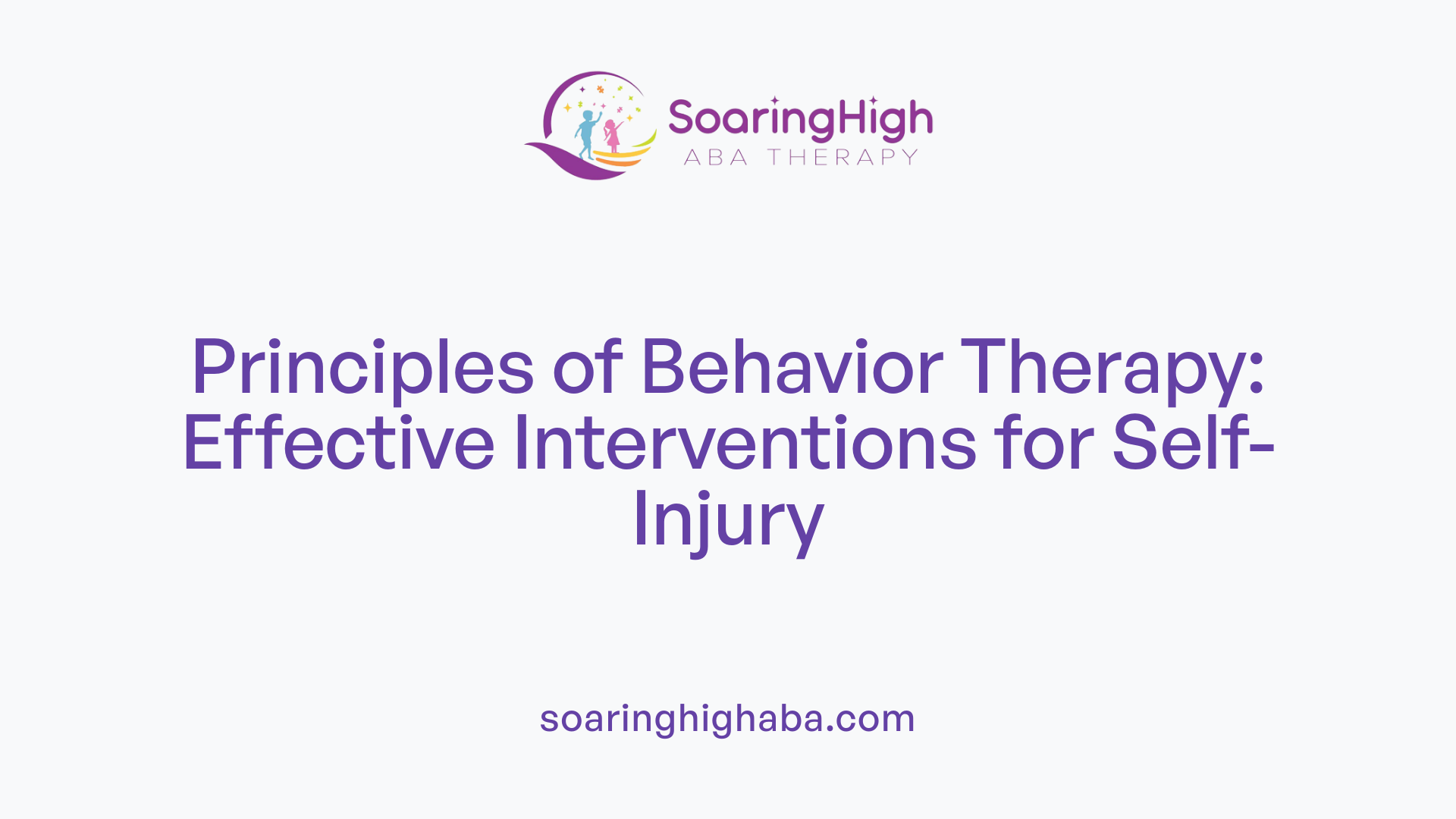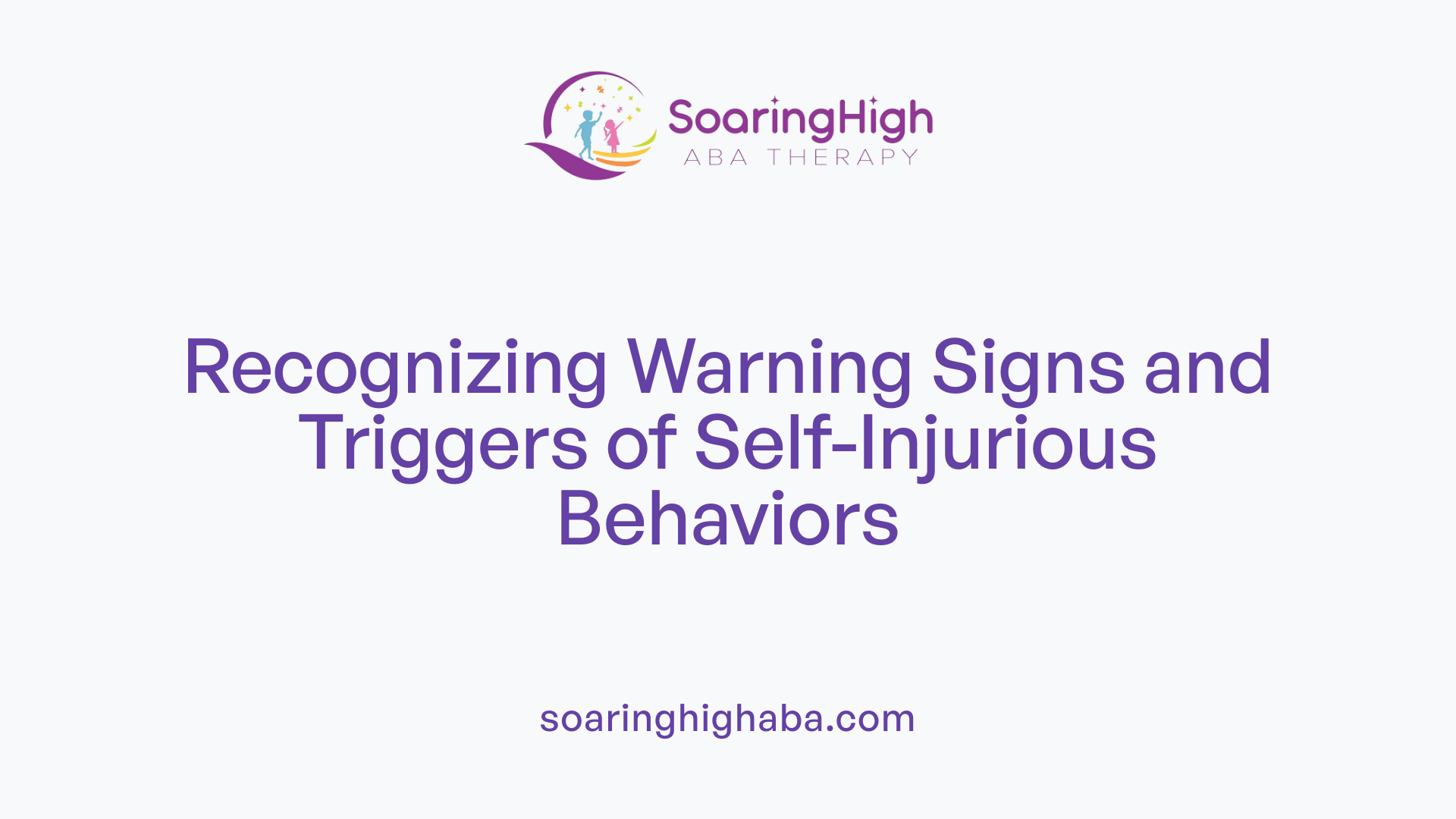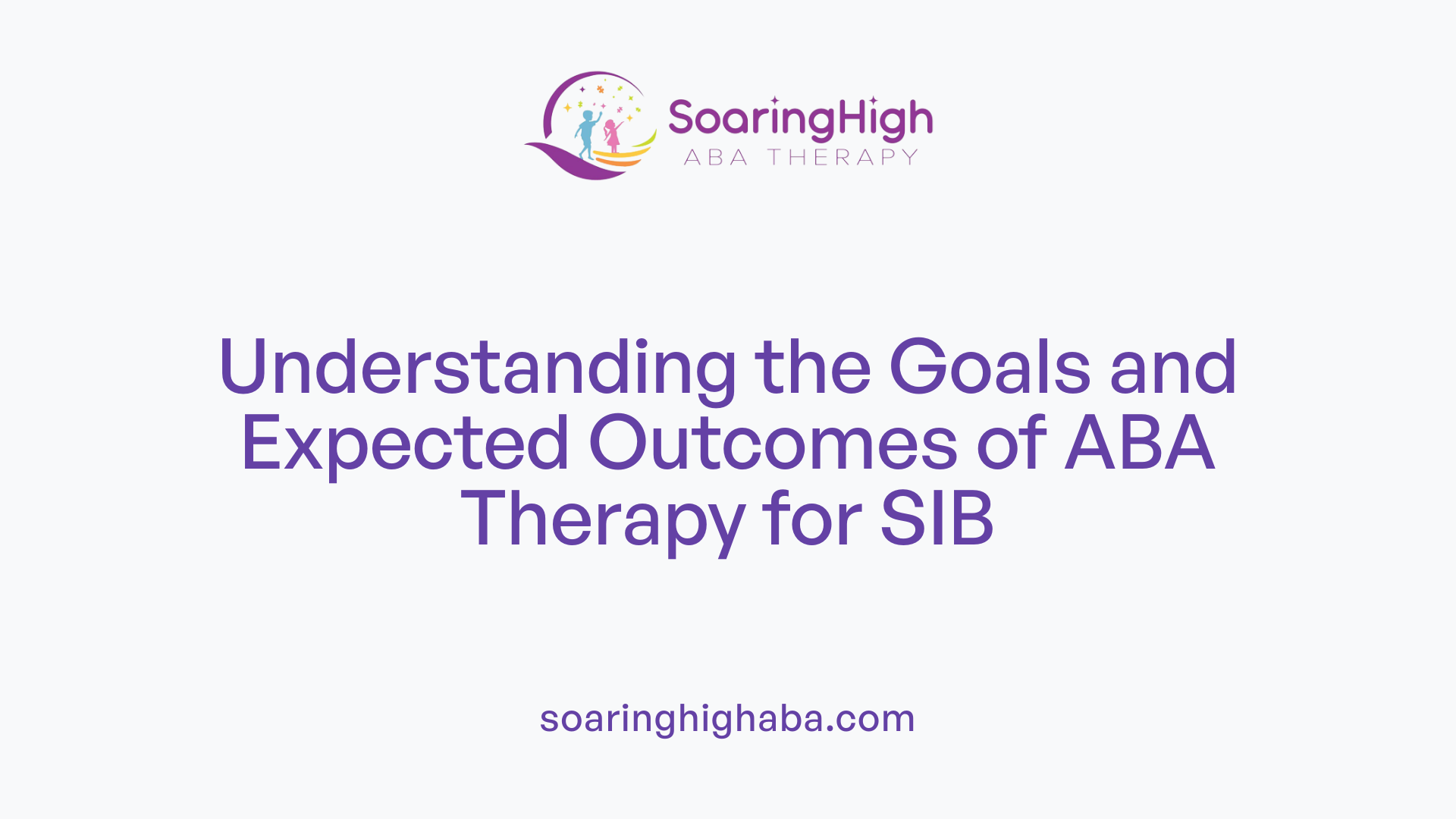Introduction to Self-Injurious Behaviors and ABA Approaches
Self-injurious behavior (SIB) is a prevalent challenge among individuals with autism spectrum disorder (ASD), often serving as a means of communication or emotional regulation. Addressing these behaviors requires a comprehensive, evidence-based approach rooted in applied behavior analysis (ABA). This article explores the underlying causes of SIB, assessment methods, and tailored interventions designed to improve safety, reduce harm, and promote functional alternative behaviors.
Understanding Self-Injurious Behaviors in Autism
What are self-injurious behaviors and why do they occur?
Self-injurious behaviors (SIB) refer to actions where individuals harm themselves, such as head banging, biting, scratching, or pulling hair. These behaviors are common among people with autism spectrum disorder (ASD) and often happen multiple times daily, especially in severe cases.
In autism, SIB frequently serve specific functions. They may be a way for individuals to communicate needs or feelings they cannot express verbally. For example, head slapping or banging might be an attempt to show frustration or protest.
Additionally, SIB can be related to sensory regulation, providing self-soothing or stimulation. Sometimes, these behaviors are a way to cope with emotional overloads like anxiety or distress.
Research shows that about 50% of individuals with ASD engage in some form of self-injury, highlighting how prevalent and impactful these behaviors can be.
What are common triggers and functions of SIB?
Understanding what triggers SIB is essential for effective intervention. Common triggers include communication challenges, environmental stressors, physical discomfort or medical issues, and emotional states like frustration or anxiety.
The functions—or reasons behind—these behaviors fall into several categories:
| Function | Description | Example Behaviors |
|---|---|---|
| Attention-seeking | To attract notice from caregivers or peers | Head banging to get a reaction |
| Tangible access | To obtain desired objects or activities | Hair pulling to access an iPad |
| Escape | To avoid unpleasant tasks or environments | Self-injury to escape a demanding task |
| Sensory stimulation | To provide internal sensory input or self-soothing | Scratching or biting for comfort |
Recognizing these functions guides caregivers and therapists in developing strategies tailored to each individual’s needs. Interventions focus on replacing harmful behaviors with appropriate alternatives that satisfy the same functions.
Assessment Techniques for Self-Injurious Behaviors
How do you assess self-injurious behavior?
Assessing self-injurious behavior (SIB) begins with an in-depth process called a Functional Behavioral Assessment (FBA). This involves gathering comprehensive information through multiple methods. First, caregivers are interviewed to gather insights about when, where, and why the behaviors occur. These reports help identify patterns and possible triggers.
Second, direct behavioral observations are carried out to record the specific contexts and antecedents that lead to SIB. During these observations, specialists may use ABC data collection—tracking the Antecedents (what happens before the behavior), the Behavior itself, and the Consequences that follow.
Third, a medical evaluation is essential to rule out any physical causes such as pain, illness, or involuntary movements like seizures that could explain or influence the behavior.
Combining these approaches provides a detailed understanding of the behavior's causes. Often, a functional analysis, a structured variation of the ABC data, is performed to test specific hypotheses about why the SIB occurs. For example, does the child engage in self-injury to seek attention, escape demands, access tangible objects, or fulfill sensory needs?
This thorough assessment allows professionals to develop tailored intervention strategies that address the root causes effectively.
Why is it important to understand the function of SIB?
Knowing the purpose behind self-injurious behaviors is crucial for effective intervention. When the function of SIB is understood, strategies can be designed to meet the individual's underlying needs, making them more effective and sustainable.
For instance, if SIB serves as a way to escape from challenging tasks, teaching alternative ways to request breaks can reduce harmful behavior. Similarly, if SIB provides sensory stimulation, sensory-based interventions can be introduced.
Interventions that do not consider the behavior's function risk being ineffective or even reinforcing the SIB. Therefore, understanding whether the behavior seeks attention, escape, sensory input, or access to tangible items ensures that intervention strategies are focused, appropriate, and more likely to succeed. Ultimately, this tailored approach significantly reduces the frequency and severity of self-injurious actions, improving quality of life for individuals with autism.
Principles of Behavior Therapy in SIB Intervention

What are effective intervention strategies?
Effective intervention begins with understanding the reasons behind self-injurious behaviors (SIB). Conducting a functional behavioral assessment (FBA) helps identify whether the SIB serves to gain attention, access tangible items, escape from demands, or provide internal sensory stimulation.
Based on the assessment, tailored behavior therapy methods are employed. Teaching alternative behaviors—such as sign language or picture exchange systems—can replace harmful actions and improve communication.
Reinforcing positive behaviors is vital. When a child uses appropriate communication or coping strategies, giving praise or tangible rewards encourages these safer actions, making it more likely they'll occur instead of SIB.
Behavior modification techniques include extinction procedures, which involve ignoring SIB when safe to do so, or response blocking, where physical guidance prevents injury. Sometimes, gentle physical interventions are used carefully to ensure safety.
Environmental adjustments and sensory strategies are also crucial. These may include sensory tools or structured routines that meet sensory needs, reducing the likelihood of self-harm driven by sensory seeking.
How does reinforcement help reduce SIB?
Reinforcement plays a central role in decreasing SIB by promoting alternative, functional behaviors. When a child learns to communicate or cope without resorting to harmful actions, and these positive behaviors are consistently rewarded, they become the preferred response.
For example, if a child bites their hand to escape a difficult task, teaching them to ask for a break and rewarding this request encourages the use of communication instead of self-injury. Over time, reinforcement builds new habits that serve the same purpose as SIB but do not harm the individual.
This strategy not only reduces the frequency of self-injury but also helps the child develop healthier ways to express needs and manage emotions. Positive reinforcement fosters a sense of achievement and safety, which is essential for ongoing behavioral improvement.
Individualized Treatment and Use of ABA Techniques
How are interventions tailored for individuals?
Interventions are customized based on a thorough understanding of the person’s unique behavior patterns, preferences, and needs. Behavior analysts conduct detailed assessments, including functional behavior assessments (FBA), which identify the reasons behind self-injurious behavior (SIB). This involves observing the behavior, gathering caregiver reports, and analyzing environmental factors.
Based on these findings, a personalized treatment plan is developed. These plans may include teaching functional communication skills like sign language or picture exchange communication systems (PECS) to help individuals express their needs more effectively. Environmental modifications, such as changing task demands or schedules, are implemented to decrease sources of frustration or sensory overload. Additionally, sensory tools like weighted blankets or sensory breaks are used to address sensory-seeking behaviors, which can decrease the urge to self-injure.
The goal of these tailored strategies is to address the specific function of the SIB—whether it's to gain attention, escape from tasks, access tangible items, or self-soothe sensory needs—thus promoting safer, more adaptive behaviors.
What role does communication training play?
Teaching functional communication skills is a core element of intervention. By providing individuals with alternative ways to communicate their feelings and needs, frustration and anxiety can be reduced, which are often triggers for SIB.
Communication training might include using sign language, picture exchange communication systems (PECS), or augmentative and alternative communication (AAC) devices. Consistent use of these tools across different environments like home, school, and community settings maximizes their effectiveness.
This approach not only diminishes problematic self-injurious behaviors but also enhances overall quality of life. When individuals can express themselves clearly, they are less likely to resort to harmful behaviors to signal their needs.
Nonpharmacological Approaches for Managing SIB

What are nonpharmacological approaches?
Nonpharmacological strategies focus on modifying the environment and teaching skills to help reduce self-injurious behaviors (SIB). These methods include environmental adjustments such as removing or securing items that might be involved in self-injury, and providing sensory tools like textured objects or calming stimuli that help regulate sensory needs.
Therapies play a significant role as well. Cognitive-behavioral therapy, mindfulness-based techniques, and social skills training can help individuals manage emotional distress and improve communication. Teaching coping skills and relaxation techniques equips individuals to handle frustration, anxiety, or sensory overload without resorting to self-injury.
By addressing the behavior's function through these approaches, caregivers and professionals can create a safer environment and support the individual in developing adaptive behaviors.
How does sensory regulation help?
Many individuals with autism engage in SIB to fulfill sensory needs or self-soothe. Providing sensory input through tools like chewable jewelry, weighted blankets, or sensory bins helps meet these needs constructively.
Sensory strategies are designed to offer alternative ways for a person to experience calming or stimulating sensations. These tools can decrease the urge to self-injure by fulfilling the sensory requirement in a safe and manageable manner.
Implementing sensory integration strategies not only promotes regulation but also enhances overall well-being, making self-injury less likely as a response to sensory or emotional overload.
Recognizing Warning Signs and Triggers of SIB

How can caregivers recognize warning signs?
Caregivers play a vital role in identifying early signs that might indicate an impending episode of self-injurious behavior (SIB). Observing physical signs such as scars, fresh cuts, bruises, or unexplained injuries can be important clues. These injuries may occur repeatedly or suddenly, which can signal ongoing self-harm. Emotional cues are equally significant; mood swings, expressions of frustration, withdrawal from social interactions, or signs of agitation can precede SIB.
Furthermore, paying attention to environmental triggers helps prevent escalation. Changes in routines, sensory overload from loud noises or bright lights, or social stressors like unfamiliar people or crowded places can act as stressors. Recognizing these early warning signs allows families and caregivers to intervene proactively, providing comfort, reducing stressors, or redirecting attention.
Promptly addressing these signs not only helps in reducing harm but also supports the individual’s emotional well-being, making interventions more effective.
What are behavioral and emotional indicators?
Behavioral indicators of SIB include repetitive actions like head banging, biting, scratching, or hair pulling. These actions often increase in frequency or intensity during stressful periods or when the individual is overwhelmed. Withdrawal from social interaction or sudden aggression can also serve as signals that the individual is struggling.
Emotional signs tend to reflect internal states such as anxiety, anger, or sadness. These may be expressed through facial expressions, vocalizations, or body language. For instance, signs of distress might include crying, screaming, or silent withdrawal.
Recognizing these behavioral and emotional cues enables caregivers to understand when the individual might be at risk of engaging in self-injury. Providing support, addressing underlying causes, and creating a calming environment can help mitigate these behaviors and promote emotional regulation.
By vigilant observation and understanding these indicators, caregivers can implement timely interventions, reducing the frequency and severity of self-injurious behaviors and improving the individual’s quality of life.
Goals and Outcomes of ABA Therapy in Addressing SIB

What are the goals of ABA therapy for SIB?
Applied Behavior Analysis (ABA) therapy aims to help individuals with autism reduce self-injurious behaviors (SIB). The main goals are to decrease how often and how severely these behaviors occur. Therapists also focus on teaching functional communication skills, so the individual can express their needs in healthier ways.
Developing adaptive skills is another crucial target. These skills help individuals manage their emotions and environmental triggers, promoting their safety and independence. Consistent monitoring of progress allows therapists to assess whether interventions are working and to make necessary adjustments.
What outcomes are expected?
Successful ABA interventions typically result in notable decreases in harmful self-injurious actions, such as head banging or biting. Additionally, individuals often learn to communicate more effectively, reducing frustration and confusion.
Improvements in engagement with appropriate activities and better safety measures are also common. Overall, these changes aim to improve quality of life, making daily routines safer and more manageable for individuals with autism and their families.
The Role of Caregivers and Professionals in Managing SIB

Conducting assessments and planning interventions
Effectively managing self-injurious behaviors (SIB) involves a thorough evaluation process. Caregivers and professionals start by conducting assessments such as Functional Behavioral Assessments (FBA), which help determine the reasons behind the behavior. These assessments consider possible functions like sensory needs, escape, attention, or access to tangibles. Based on the results, personalized intervention plans are created to address the specific needs of the individual.
This process often includes a detailed analysis of when and where SIB occurs, what triggers it, and what consequences reinforce it. Combining caregiver reports, behavioral observations, and medical evaluations ensures a comprehensive understanding. The goal is to develop strategies that reduce triggers and teach safer, alternative behaviors.
Teaching and reinforcing strategies
Teaching appropriate communication and coping skills is crucial. Interventions focus on reinforcing positive behaviors and teaching new, functional skills that serve the same purpose as the SIB. For example, if a child bites when frustrated, they might be taught to use sign language or picture exchange communication system (PECS) to express their needs.
Reinforcement techniques like praise, tangible rewards, and consistent responses encourage the adoption of desirable behaviors. Using visual schedules, sensory tools, and calm routines can help meet sensory or emotional needs, reducing the likelihood of self-harm. The use of extinction procedures, such as ignoring SIB or using response blocking, is also common.
Monitoring and collaboration
Regular monitoring is essential to assess whether interventions are effective. Data collection methods, including ABC (antecedent-behavior-consequence) charts, provide ongoing insight into the behavior patterns. Adjustments to treatment plans are made based on these findings.
Collaboration among caregivers, behavior analysts, teachers, and healthcare providers fosters consistency across all environments. Training caregivers ensures strategies are applied correctly in daily life, which maximizes their effectiveness. Building a strong support network helps sustain progress and addresses challenges as they arise.
Ongoing cooperation, open communication, and shared goals are vital. When everyone involved works together, the management of SIB becomes more successful, promoting safer behaviors and improved quality of life for individuals with autism.
Summary and Future Directions
Effectively addressing self-injurious behaviors in autism requires a comprehensive understanding of the behaviors' functions, thorough assessment, and individualized interventions grounded in ABA principles. Combining behavioral strategies with environmental modifications, communication training, and caregiver involvement can lead to meaningful improvements. Continued research, caregiver education, and collaboration among professionals are essential to advance effective management and improve the quality of life for individuals with ASD.
References
- Causes and Interventions for Self-Injury in Autism
- The association between self-injurious behaviors and autism ...
- Intervention Strategies for Self-Injurious Behaviors - Watson Institute
- Management of Self-Injurious Behaviors in Children with ...
- Self-Injurious Behaviors in Children with Autism | Aim Higher ABA
- Self-Injurious Behavior | CHOP Research Institute
- Self-injurious behaviour - a guide for all audiences
- ABA Therapy for Self-Injury - Therapyland





































































































